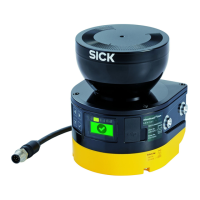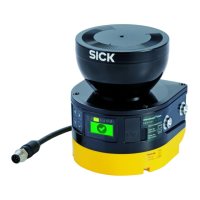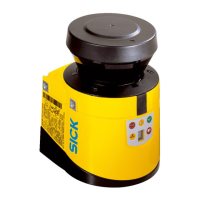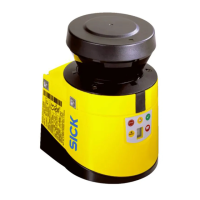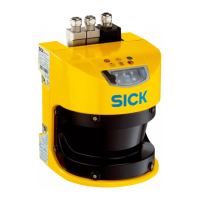NOTE
SIC
K offers a stopping/run-down time measurement service in many countries.
Calculation example of the minimum distance S according to ISO 13855
T
he example shows the calculation of the minimum distance for an orthogonal
approach to the protective field. A different calculation may be required depending on
the application and the ambient conditions (for example, for a protective field parallel to
or at any angle to the direction of approach or an indirect approach).
b
First, calculate S using the following formula:
S = 2000 mm/s × T + 8 × (d – 14 mm)
where:
°
S = minimum dis
tance in millimeters (mm)
°
T=stopping/run-down time for the entire system in seconds (s)
(Response time of the safety laser scanner + machine’s stopping/run-down
t
ime, incl. response time of the machine’s control system and signal propaga‐
tion time)
°
d = r
esolution of the safety laser scanner in millimeters (mm)
The reach/approach speed is already included in the formula.
✓
If t
he result S is ≤ 100 mm, use S = 100 mm.
✓
If the result 100 mm < S ≤ 500 mm, use the calculated value as the minimum
distance.
b
If the result is S > 500 mm, you may be able to reduce the minimum distance
using the following calculation:
S = 1600 mm/s × T + 8 ×(d – 14 mm)
✓
If the new value is S > 500 mm, use the newly calculated value as the minimum
distance.
✓
If the new value S is ≤ 500 mm, then use 500 mm as the minimum distance.
4.3.8 Access protection
Overview
In a s
tationary application, for example on a machine where the point of access to the
hazardous area can be physically defined, the safety laser scanner is mounted with a
vertical scan plane. For access protection, the safety laser scanner detects an intrusion
by a whole body. The protective field is orthogonal to the person’s direction of approach.
4 P
ROJECT PLANNING
44
O P E R A T I N G I N S T R U C T I O N S | microScan3 Pro I/O 8025424/1ELL/2022-01-21 | SICK
Subject to change without notice
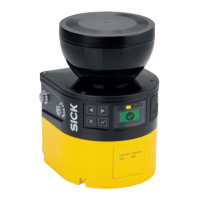
